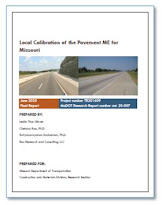Safety has become an area of increasing focus in all aspects of transportation planning, design, construction, and operations. Transportation legislation, such as the SAFETEA-LU Act (2005) and the FAST Act (2015), have promoted data driven safety analysis in various programs. The publication of the Highway Safety Manual (2010) and the Supplement (2014) have standardized data driven safety methodology and developed related tools such as spreadsheets and the ISATe (Enhanced Interchange Safety Analysis Toolbox).
The demand for knowledge and experience in data driven safety analysis has been increasing. This report documents a project to produce data driven safety training for MoDOT trainers. The project developed two training deliverables.
The first is a full-day training for safety staff and engineers. This training covers the fundamentals of data driven safety, rural multilane divided highways, urban/suburban 4-leg signalized intersections, urban 4-lane freeway segments, and four sample applications: design exception, traffic impact study, design build, and safety programming. The second was a 15-minute video that
presents an overview of data-driven safety and is suitable for staff at various levels, even those without formal safety training. A goal of this project is to produce flexible training materials that can meet the training needs of various MoDOT districts and divisions.
VIEW FINAL REPORT
Report number: cmr 20-008
Published: June 2020
Project number: TR201908
Authors: Carlos Sun, Praveen Edara, Yaw Adu-Gyamfi, Mohammadmehdi Zoghifard, and Ziyi Huang
Performing organization: University of Missouri-Columbia


